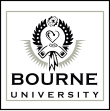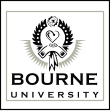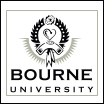© bOURNE uNIVERSITY 2021

THE BOURNE JOURNAL OF
ARCHAEOLOGY
OXFORD UNIVERSITY ANNOUNCES DISCOVERY OF
JEBIDIAH SMITH'S YITH CRYSTAL
London l The prestigious Oxford University, institution of the famed 19th Century Oxford Professor Jebidiah E. Smith, and publisher of his most famous work, "A Commentary on the Book of Gates", has announced the discovery of the long lost "Yith Crystal" of the notorious Yidath Cult, in the abandoned warehouse on the southside of London. The Oxford Press released the statement in it's official campus circulation, The Formal Scientist, that the university's 150 year old search for the mysterious artifact had finally been concluded as it uncovered the notorious 19th century cult began by the famed professor, which was used in the cult's religious Yidathian rituals which often involved human sacrifice. The abandoned warehouse section, where Smith conducted the Yidath Cult rituals in secret with his followers. The warehouse still contains art, magical signs and etchings from the period when Smith lived, of which location has not been revealed by Scotland Yard due to the continued investigation into the Smith enigma. The highly sought after "Yith Crystal" is an archaeological relic of unexplained origin, rumored to have been procured by the denizens of the ancient continent of Yidath and the First Gods from Earth's first moon, Yith, which were used in worshiping ceremonies some billions of years ago. The relic was reported to have come from the surface of the blue moon itself and to possess powerful magical properties, from supernatural and demonic to unnamable, which within the ritual use could even conjure, Smith claimed, the presence of his "First Gods", according to scholars. One of two photos known to exist of Professor Jebidiah Smith at the Tilbost House in Abington, England. Scholars question the authenticity of the photo and compare the image to common spiritualist 'ghost' photography of the day. The creature is reported to be a Vr'ugg, an ancient denizen of Yidath. From the Oxford Collection. The Yith Cult was said to have had influential members in high levels of political, scientific and religious circles throughout Europe. Most known were members of the British Royal Family, who, using their influence barred Scotland Yard from interfering with Smith's criminal activities until 1869. Vatican officials, the American Museum of Natural History and the Museo Nazionele de San Marco in Italy which opened the same year, French political Emile Olliver as well as the discoverer of DNA, Friedrich Miescher of the Physiology Institute of the University of Leipzig, Germany, were reported to have corresponded with Smith regarding the Yidath Cult. Professor Smith, after abandoning his tenure at Oxford University after contributing to the Oxford University Museum of National History's collections from his expeditions to exotic destinations around the ancient world, began the Yidath Cult after his revelations in the translations of the Book of Gates into his most famous work, "A Commentary on the Book of Gates, first published by Oxford Press in 1868. The famous and rare Book of Gates, of which only a dozen are known to exist, was said to have been written by an Eemian prophet from tablets transcribed on ancient stone plates that told the ancient history of the first continent, Yidath. These have never been found, say scholars. The Tilbost House in Abingdon, England. Now in possession of the British government in cooperation with the Smith family, the house was known to be the center of strange activities up until Smith's disappearance. The house remains empty today. He vanished shortly after when the cult warehouse and his mansion in Abington, the Tilbost House, was raided by Scotland Yard after reports of criminal activity, in which he fled the country to Arabia, where he vanished in the Saudi Empty Quarter in 1870, searching for his legendary Pyramids of Xoth. He was presumed officially dead in 1871, according to police files.












CURRENT ISSUE

Member Since May 1922
Explore
Discover
Find
Catalog
Publish
Reward

LONDON-ROME-BERLIN-MOSCOW-NAPLES


Recent Articles
Proud Sponsor of Bourne’s Journal
Sponsored Works
News of the World





related posts
SHARE ON:
SHARE ON:


© bOURNE uNIVERSITY 2021
THE BOURNE JOURNAL OF
ARCHAEOLOGY

OXFORD UNIVERSITY ANNOUNCES DISCOVERY
OF JEBIDIAH SMITH'S YITH CRYSTAL
London l The prestigious Oxford University, institution of the famed 19th Century Oxford Professor Jebidiah E. Smith, and publisher of his most famous work, "A Commentary on the Book of Gates", has announced the discovery of the long lost "Yith Crystal" of the notorious Yidath Cult, in the abandoned warehouse on the southside of London. The Oxford Press released the statement in it's official campus circulation, The Formal Scientist, that the university's 150 year old search for the mysterious artifact had finally been concluded as it uncovered the notorious 19th century cult began by the famed professor, which was used in the cult's religious Yidathian rituals which often involved human sacrifice. The abandoned warehouse section, where Smith conducted the Yidath Cult rituals in secret with his followers. The warehouse still contains art, magical signs and etchings from the period when Smith lived, of which location has not been revealed by Scotland Yard due to the continued investigation into the Smith enigma. The highly sought after "Yith Crystal" is an archaeological relic of unexplained origin, rumored to have been procured by the denizens of the ancient continent of Yidath and the First Gods from Earth's first moon, Yith, which were used in worshiping ceremonies some billions of years ago. The relic was reported to have come from the surface of the blue moon itself and to possess powerful magical properties, from supernatural and demonic to unnamable, which within the ritual use could even conjure, Smith claimed, the presence of his "First Gods", according to scholars. One of two photos known to exist of Professor Jebidiah Smith at the Tilbost House in Abington, England. Scholars question the authenticity of the photo and compare the image to common spiritualist 'ghost' photography of the day. The creature is reported to be a Vr'ugg, an ancient denizen of Yidath. From the Oxford Collection. The Yith Cult was said to have had influential members in high levels of political, scientific and religious circles throughout Europe. Most known were members of the British Royal Family, who, using their influence barred Scotland Yard from interfering with Smith's criminal activities until 1869. Vatican officials, the American Museum of Natural History and the Museo Nazionele de San Marco in Italy which opened the same year, French political Emile Olliver as well as the discoverer of DNA, Friedrich Miescher of the Physiology Institute of the University of Leipzig, Germany, were reported to have corresponded with Smith regarding the Yidath Cult. Professor Smith, after abandoning his tenure at Oxford University after contributing to the Oxford University Museum of National History's collections from his expeditions to exotic destinations around the ancient world, began the Yidath Cult after his revelations in the translations of the Book of Gates into his most famous work, "A Commentary on the Book of Gates, first published by Oxford Press in 1868. The famous and rare Book of Gates, of which only a dozen are known to exist, was said to have been written by an Eemian prophet from tablets transcribed on ancient stone plates that told the ancient history of the first continent, Yidath. These have never been found, say scholars. The Tilbost House in Abingdon, England. Now in possession of the British government in cooperation with the Smith family, the house was known to be the center of strange activities up until Smith's disappearance. The house remains empty today. He vanished shortly after when the cult warehouse and his mansion in Abington, the Tilbost House, was raided by Scotland Yard after reports of criminal activity, in which he fled the country to Arabia, where he vanished in the Saudi Empty Quarter in 1870, searching for his legendary Pyramids of Xoth. He was presumed officially dead in 1871, according to police files.









related posts
SHARE ON:
SHARE ON:


Recent Articles

Sponsored Works
Proud Sponsor of Bourne’s Journal





© bOURNE uNIVERSITY 2021
OXFORD UNIVERSITY
ANNOUNCES DISCOVERY OF
JEBIDIAH SMITH'S YITH
CRYSTAL
London l The prestigious Oxford University, institution of the famed 19th Century Oxford Professor Jebidiah E. Smith, and publisher of his most famous work, "A Commentary on the Book of Gates", has announced the discovery of the long lost "Yith Crystal" of the notorious Yidath Cult, in the abandoned warehouse on the southside of London. The Oxford Press released the statement in it's official campus circulation, The Formal Scientist, that the university's 150 year old search for the mysterious artifact had finally been concluded as it uncovered the notorious 19th century cult began by the famed professor, which was used in the cult's religious Yidathian rituals which often involved human sacrifice. The abandoned warehouse section, where Smith conducted the Yidath Cult rituals in secret with his followers. The warehouse still contains art, magical signs and etchings from the period when Smith lived, of which location has not been revealed by Scotland Yard due to the continued investigation into the Smith enigma. The highly sought after "Yith Crystal" is an archaeological relic of unexplained origin, rumored to have been procured by the denizens of the ancient continent of Yidath and the First Gods from Earth's first moon, Yith, which were used in worshiping ceremonies some billions of years ago. The relic was reported to have come from the surface of the blue moon itself and to possess powerful magical properties, from supernatural and demonic to unnamable, which within the ritual use could even conjure, Smith claimed, the presence of his "First Gods", according to scholars. One of two photos known to exist of Professor Jebidiah Smith at the Tilbost House in Abington, England. Scholars question the authenticity of the photo and compare the image to common spiritualist 'ghost' photography of the day. The creature is reported to be a Vr'ugg, an ancient denizen of Yidath. From the Oxford Collection. The Yith Cult was said to have had influential members in high levels of political, scientific and religious circles throughout Europe. Most known were members of the British Royal Family, who, using their influence barred Scotland Yard from interfering with Smith's criminal activities until 1869. Vatican officials, the American Museum of Natural History and the Museo Nazionele de San Marco in Italy which opened the same year, French political Emile Olliver as well as the discoverer of DNA, Friedrich Miescher of the Physiology Institute of the University of Leipzig, Germany, were reported to have corresponded with Smith regarding the Yidath Cult. Professor Smith, after abandoning his tenure at Oxford University after contributing to the Oxford University Museum of National History's collections from his expeditions to exotic destinations around the ancient world, began the Yidath Cult after his revelations in the translations of the Book of Gates into his most famous work, "A Commentary on the Book of Gates, first published by Oxford Press in 1868. The famous and rare Book of Gates, of which only a dozen are known to exist, was said to have been written by an Eemian prophet from tablets transcribed on ancient stone plates that told the ancient history of the first continent, Yidath. These have never been found, say scholars. The Tilbost House in Abingdon, England. Now in possession of the British government in cooperation with the Smith family, the house was known to be the center of strange activities up until Smith's disappearance. The house remains empty today. He vanished shortly after when the cult warehouse and his mansion in Abington, the Tilbost House, was raided by Scotland Yard after reports of criminal activity, in which he fled the country to Arabia, where he vanished in the Saudi Empty Quarter in 1870, searching for his legendary Pyramids of Xoth. He was presumed officially dead in 1871, according to police files.





THE BOURNE JOURNAL OF
ARCHAEOLOGY



SHARE ON:
SHARE ON:


Member Since May 1922
Explore
Discover
Find
Catalog
Publish
Reward

LONDON-ROME-BERLIN-MOSCOW-NAPLES



Proud Sponsor of Bourne’s Journal


Like our Sponser





